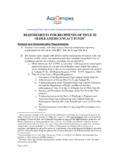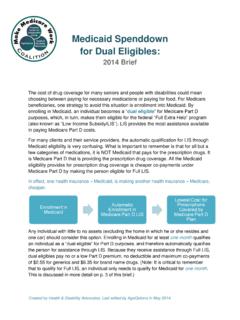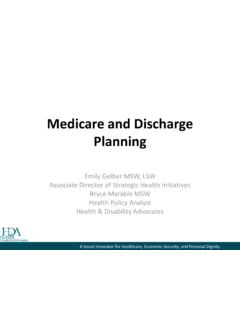Transcription of Title III-C Nutrition Services: Congregate and Home ...
1 1 Title III-C Nutrition services : Congregate and home delivered Meals DEFINITIONS: See below UNIT OF SERVICE: Each meal served or delivered to an eligible participant. The following definitions and standards are applicable to both Congregate and home delivered Meals providers, unless otherwise specified. Standards that are applicable to Congregate programs are labeled 'C1' and standards that are applicable to home delivered Meals programs are labeled 'C2'. PROGRAM DEFINITIONS MEALS Title III-C1 Congregate Meals C1 The provision of one hot or other appropriate meal to eligible participants on at least a five-day a week basis, served in Congregate settings. Exceptions to the five-day a week program may be granted.
2 Sites must be open to the public and appear welcoming to outside participants. Title III-C2 home delivered Meals C2 The provision of one hot or other appropriate meal to eligible participants on at least a five-day a week basis and delivered to the participant's home . Eligibility must be assessed and determined eligible by the Case Coordination Unit (CCU). Meals may be delivered fewer than five days per week, but some daily contact with the client must be offered. Meals must be delivered directly to the participant. Meals must not be left outside the participant s door or delivered to someone other than the participant. Meals C1, C2 The meal must comply with the menu planning standards based on the most recent Dietary Guidelines for Americans, published by the Secretary of Health and Human services and the Secretary of Agriculture and meet the minimum requirements of the Dietary Reference Intakes (DRIs) as established by the Food and Nutrition Board of the Institute of Medicine of the National Academy of Sciences.
3 The calculated values of these meals may be averaged over three consecutive days to establish compliance with the DRI. 2 home delivered Meals C2 If the applicant is approved by AgeOptions, they may provide Special Diets, an extra meal on Friday for weekend consumption/ weekend meals, or second meals to clients based on the Care Coordination Unit s assessment of the client and whether the client is at high Nutrition risk (a score of six points or above on the Nutrition Risk Assessment Tool). Menu Pattern C1, C2 The meals planned must follow the menu planning standards as outlined in the Menu Standards. PROGRAM REQUIREMENTS Eligibility C1 A Nutrition service provider must serve persons: Age 60 years and over, The 60+ participant s spouse regardless of age Individuals who are disabled and under age 60 if they reside in a housing facility for older adults and persons with disabilities at which Congregate Nutrition services are provided.
4 A Individuals with disabilities who reside with a person over 60 in a non-institutional household are eligible for a meal. If special interest groups, such as faith based organization, social organizations, and homes for the elderly, senior housing developments, etc. are operating a Congregate program, participation may not be limited to their own membership or otherwise show preferential treatment for such membership. Providers must demonstrate and verify that their programs are available and accessible to the general public. If a proposed site is co-located with an Adult services Center, there should be a separate entrance and area for dining. If a site is proposed in a Senior Housing facility, the program must be open and inviting to any older adult (not just residents).
5 Guests, volunteers and staff under age 60 may be offered a meal if it does not deprive an older person of a meal. Staff or guests must pay the full cost of the meal, exclusive of in-kind. If a meal is offered 3 to a staff person, it should be offered as a fringe benefit and be included as employee fringe benefit costs in the budget. Employees are responsible for any tax liability on the value of the fringe benefit. Meals served to staff, volunteers, and/or non-eligible guests under the age of 60 will not be reimbursed by AgeOptions. C2 A Nutrition service provider shall serve persons age 60 years and over, who are assessed by the Care Coordination Unit as being frail and/or homebound for periods of three days or more because of acute or chronic illness, incapacitating illness or are otherwise isolated which leaves them unable to shop, prepare or obtain meals.
6 Other eligibility requirements include at least one of the following: Persons unable to participate in the Congregate meals program; Persons for whom no adult is available or willing to prepare the meals; Persons who have special dietary which can be met by the home delivered meal program. The person must also agree to cooperate in the delivery procedures of the Nutrition program provider. A spouse of an eligible frail and/or homebound individual may receive a home delivered meal if desired and if (1) Provision of the meal relieves the spouse of undue stress in the daily care of the client, or (2) The spouse has demonstrated an inability to adequately provide meals for both members due to lack of knowledge, equipment, skill, or capacity.
7 Under the Older American s Act, individuals with disabilities, regardless of age, who reside at home with older individuals, may receive a home delivered meal. Disabled individuals [as defined in OAA Section 102(13)] who have not attained 60 years of age but who reside in housing facilities occupied primarily by the elderly at which Congregate Nutrition services are provided. Funded Agencies will provide home delivered meals only after the local Case Coordination Unit (CCU) has determined eligibility for service via an in- home assessment. The CCU may authorize meal service prior to an in- home assessment if there are extenuating circumstances, such as recent hospital discharge. The meal provider and the CCU must work together with to ensure that an in- home assessment will take place in a timely fashion for all clients.
8 4 For more detail, see AgeOptions home delivered Meal Guidelines in the attachments. The CCU and Nutrition service provider must follow AgeOptions home delivered Meal Assessment Guidelines, available under separate cover. C1, C2 Persons under age 60 who provide volunteer services during meal hours may be offered a meal on the same basis as elderly participants. Waiting List Report C1, C2 Prior to starting a waiting list, the provider should contact AgeOptions. After the waiting list starts, the provider must submit monthly updates to AgeOptions which include the number of people waiting for service and the reason that a wait exists ( driver shortages, kitchen capacity). This information should be submitted with the monthly reimbursement request.
9 Private Pay Meals C2 If providers have a waiting list due to cash flow, they may establish a private pay meal program. Clients should be charged the full cost of the meal not including inkind costs. Once the waiting list is cleared, private pay clients should be offered a meal paid by AgeOptions funding if they are eligible. Target Population C1, C2 Nutrition service providers must identify and document methods to assure that priority is given and projections are met to reach older persons with the greatest social and economic need, particularly ethnic, minority and limited English speaking senior populations. Community Input C1, C2 Nutrition service providers must develop and document methods to elicit community input to help support the mission of the program.
10 This input can be in the form of views, services , or volunteers. Community input may consist of: offering participants in the program opportunities to provide input, soliciting input from non-participants who are 60 and over at community and site events, inviting community representatives to Site Advisory Council meetings, soliciting volunteers, services and monetary support from local businesses and community groups, and initiating joint 5 ventures between community/business groups and the Nutrition site/distribution point. The Nutrition service provider should solicit the advice and expertise of individuals, community agencies and community resource organizations that are knowledgeable about the needs of older individuals.





